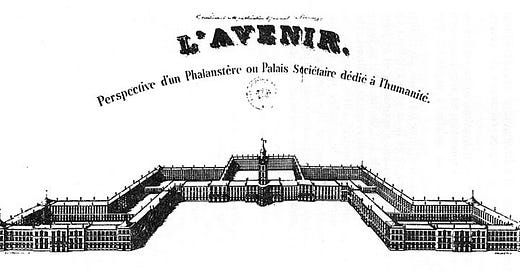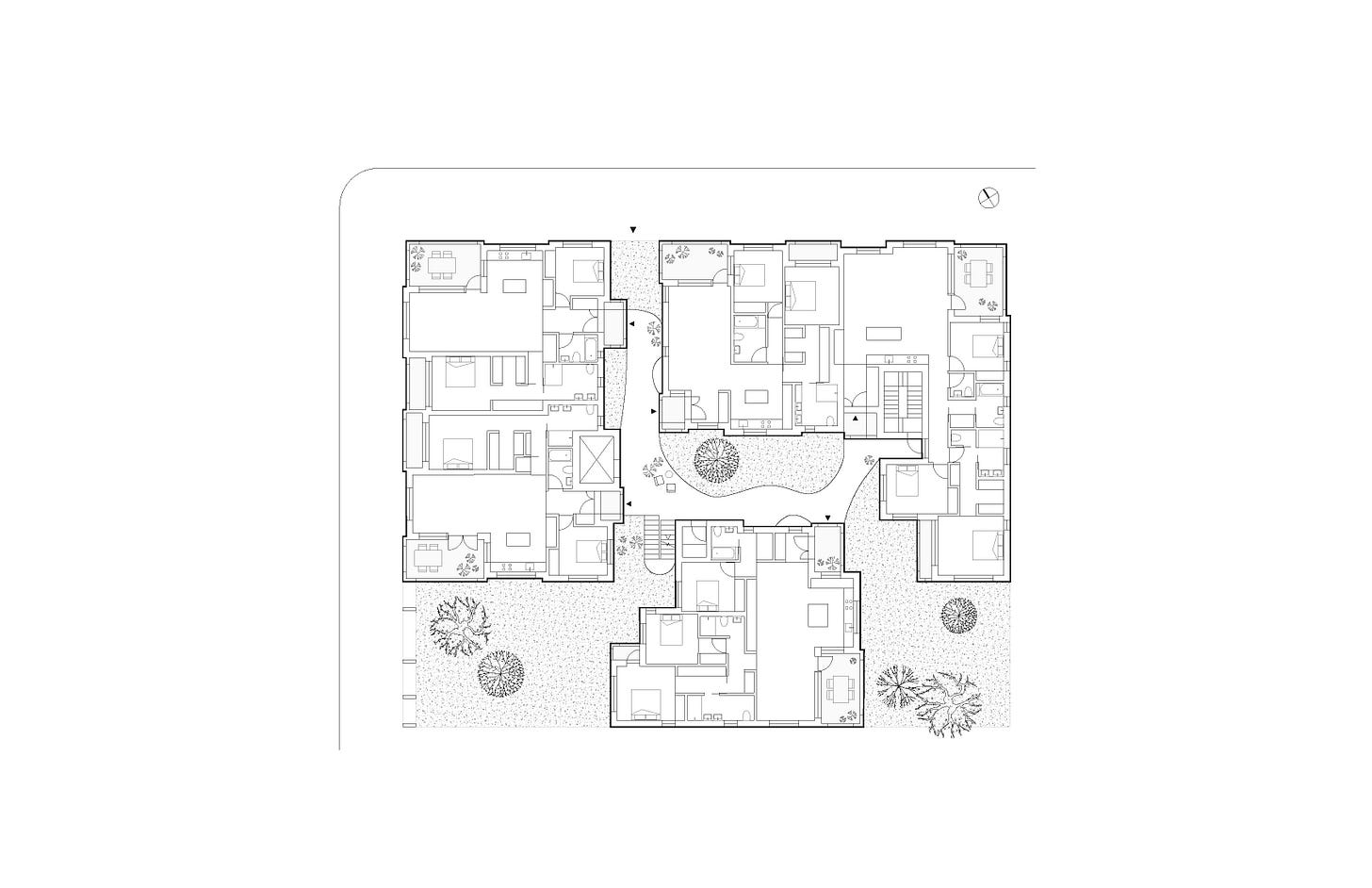Welcome! If someone forwarded you SKYLINE, sign up here to receive it weekly.
Fall is upon us, and with that the conversation around architecture heats up again. We added more than 120 events to our list over the weekend, including the full fall lecture schedules of Yale, SCI-Arc, Harvard and MIT. See this week’s offerings below, and the full list here.
This morning, I am sharing a polemic I penned for #19, ‘Cancel the Corridor.’
CANCEL THE CORRIDOR
by Nicolas Kemper
“I was shocked to discover what sort of state is acceptable here,” Florian Idenburg, co-principal and co-founder of the architecture firm SO-IL, tells me. I was talking with him about a New York design crutch that impoverishes residential living here by comparison to his native Netherlands: the double-loaded corridor. What’s the case against double loading a corridor? “Well I would turn that question around and ask: can you tell me one thing going for double-loaded corridors?” says Sam Alison-Mayne, the head of the Brooklyn developer Tankhouse.
So called because rooms load onto it from both sides, double-loaded corridors are a problem for Alison-Mayne because of the light and ventilation they deny to the units they connect. Want an apartment with light from three sides? Cross ventilation? A balcony or a deck? If the building uses double-loaded corridors, then you better be ready to pay up for a corner unit or a penthouse. Idenburg emphasizes the lost potential of the connecting spaces themselves. As he wrote in an October piece in The Architect’s Newspaper, “Can we imagine the journey from apartment to street as joyous and celebratory, filled with daylight, fresh air, and lush plants? Not a furtive flight but a languid promenade, with spaces for repose along the way?”

SO-IL and Tankhouse have gone further than imagining—they are building a series of double-loaded corridor–free buildings in Brooklyn, beginning with the recently topped off 450 Warren Street. How do you get around without a double-loaded corridor? There are three main methods: puncture your building with circulatory courtyards (possibly wrapped with an arcade or single-loaded corridor), allow for direct circulation from room to room (upscale: enfilade; downscale: shotgun), or turn each unit into its own separate pavilion, forming together a campus, a solution embraced (with the exception of MIT) by older American colleges. At 450 Warren, Tankhouse and SO-IL are using a courtyard crossed by a series of curved exposed walkways. Complete with trees, stoops, and the occasional bench, they connect the units to one another, all of which subsequently receive light from three sides, have balconies, and enjoy cross ventilation. In this understated but wildly complex design, a unit owner will walk outside to access the elevator as though the street begins at their front door.
The corridor’s likeness to the street is what first enticed Dr. Earle Chambers, Director of Research in the Department of Family and Social Medicine Research at the Albert Einstein College of Medicine, to study apartment hallways and foyers. He had been interested in the connections between the walkability of lower-income neighborhoods and the health of their inhabitants. Realizing that similar concepts used to measure walkability outdoors might also translate to indoor spaces, he received a $750,000 grant in 2010 from the John D. and Catherine T. MacArthur Foundation to look at the links between housing and the cardiovascular health of Latinos in the Bronx. Along with collecting health information from 371 low-income Latino families in the Bronx living in affordable housing, his researchers examined 291 units, diagramming room adjacencies, the doors connecting them, and noting the function of each room. The researchers then sorted the apartments into two categories: “circulation-centered,” where rooms are connected by spaces designated almost exclusively for circulation (that is, corridors); or “living-centered,” where rooms are connected via communal spaces, such as a living room or kitchen. The paper Chambers authored in 2018 with Dr. Sonit Bafna, an architecture professor at Georgia Institute of Technology, and architect Herminia Machry demonstrated that interviewees living in circulation-centered apartments were significantly more likely to experience symptoms of depression. Why? The authors speculated the cause may be related to depth—the distance from private to social space. The more depth a layout has, the more socially isolated its inhabitants are, and social isolation can be, said the study, “a significant predictor of health problems,” including stress.

The possible connection to stress may be because corridors are often symptoms of a hierarchical social structure. That is to say, the first corridors were designed not by their users, but those who use their users. In his 2010 piece “Corridor Spaces,” for the journal Critical Inquiry, architectural historian Mark Jarzombek writes that in the fourteenth century, corridor meant someone who runs fast, carrying the orders of commanders. That took on an architectural meaning: “spaces in fortifications that enabled rapid communication with troops.” Widespread use began with barracks design—so much so that Germans would use the word Barackenstil to describe buildings with double-loaded corridors, such as schools and hospitals. Jarzombek emphasizes the class implications. Double-loaded corridors showed up in barracks, palaces, and institutions as spaces where the commanded can access their commanders, without risking solidarity.
Paradoxically, through its history, the double-loaded corridor also repeatedly played a starring role in utopian visions—perhaps because, again like a street, a corridor can be a space of potential spontaneity, surprise, and subversion. In his 2019 book Corridors: Passages of Modernity, Roger Luckhurst foregrounds the phalanstère—a self-contained utopia that resembles a university or mental institution, and that centers around double-loaded corridors—designed by the French theorist Charles Fourier. They were to facilitate not just spontaneous contact, but spontaneous sex. These utopian structures, writes Luckhurst, were intended “to dismantle all prior social relations, most particularly the bourgeois family, folded in on itself behind closed doors.”
A good street privileges both movement and sex—well, it provides the sort of generous amenities (light, air, nature, a place to sit) that foster spontaneous interactions and, by extension, civil society. New York has been extremely intentional about its streets, to the point where the most stringent rules shaping buildings are rooted in maximizing the amount of light and air in the streets. Yet New York has had different priorities with its internal streets. The city is full of corridors without natural light and natural ventilation, much less plants or anywhere to sit. These corridors are not only legal, but often, per building code, mandatory. Rules aimed at making fire stairs safe during a fire make them miserable places to be at any other time. The energy code, in turn, punishes a building for adding the extra envelope necessary for cross ventilation. Finally, the building code privileges conditioned—that is, heated and cooled—spaces. While these are well-intentioned rules aimed to keep inhabitants safe and warm, their consequence is, as Idenburg puts it, “everything that is unheated is chopped off, and what you are left with is a box.” Idenburg points to a movement in Switzerland to heat only the rooms in which we spend significant time, such as the kitchen and living rooms, and leave everything else unheated. By contrast, “In the US there is the outside, then total control of the inside.”
While Alison-Mayne bets the extra light and cross ventilation will sell units at 450 Warren, he sees Tankhouse’s work, too, as beginning with streets, specifically the qualities of Brooklyn’s streets and public spaces. Those qualities, like those of cities in the Netherlands, may have much to do with the simple lack of towers, and therefore the tendency of units to connect via open streets, not corridors. 450 Warren—and two more projects underway, 219 Jay Street and a building in Fort Greene—represent a test of whether those qualities can extend into high-rise living.
As a high-end development, it may be easy to write off 450 Warren as a high-end solution (units begin at $1.7 million), but SO-IL’s earlier experiment with a double-loaded corridor–free building, its 2012 competition entry, named tiNY, for adAPT NYC focused on affordable housing. It placed micro-units on a seasonally open-air single-loaded corridor, such that each unit would have cross ventilation and receive light from both sides. In Singapore, code and a cultural aversion to double-loaded corridors makes them rare at any price point. For the health and happiness of New Yorkers everywhere, hopefully city leaders here too can amend the building code to make our internal streets as good as our external.
A DISPATCH
8/19 - Terracotta comes to Pittsburgh
The Architectural Ceramic Assemblies Workshop, a six-hour look at the future of terracotta in construction, combined presentations from eight teams who each spent six months studying terracotta with two keynotes, by TOD WILLIAMS & BILLIE TSIEN (New York architects and NYRA subscribers) and MIC PATTERSON (author of Structural Glass Facades and Enclosures and self-described “Individual Façade Geek”). WILLIAMS & TSIEN celebrated the irregularity that from imperfection in the manufacturing process and through the natural degradation of material – per WILLIAMS, “We like tough beauty, where the beauty feels a little fragile.” In PATTERSON’s keynote, the hot take that stood out to me (among many sustainability aphorisms) was, “The most sustainable building is the one we did not build.” Could architects operate without designing buildings? Is there a future where architects primarily work on retrofits, or use the skills we learn in school to work on new kind of projects? - Charles Weak
ANNOUNCEMENTS
NYRA WON A GRANT!
We are happy to share that we are among the 2021 grant recipients from the Graham Foundation! We are proud to be among such good company, and grateful for the support.
ARCHITECTURAL LEAGUE SEEKS MENTORS
The Architectural League is looking for participants in its mentor program, “An annual program fostering student-mentor connections among architecture students and design professionals in the New York City area.” Having personally participated in it for two years, I would highly recommend. Information here, application here. Deadline September 10.
SAVE THE GRAND PROSPECT HALL!

One of the most fabulous, vast - yet affordable (and need we mention, enfilade?) -party venues in New York is slated for demolition. Article here, petition here.
DATELINE
The week ahead
Tuesday, 8/31
FALL 2021 ALL SCHOOL ASSEMBLY with Nora Akawi, Steven Hillyer, Nader Tehrani, Ted Baab, Rychiee Espinosa, Mersiha Veledar, Nima Javidi, Julian Palacio, Ryan Brooke Thomas, Samuel Anderson, Daisy Ames, Pamela Cabrera, Thorsten Helbig, Elisa Iturbe, James Lowder, Florian Meier, Diana Agrest, Gary Bates, Susannah Drake, Alysen Hiller Fiore, Joshua Ramus, Benjamin Aranda, Hayley Eber, Michael Young, Guido Zuliani, Sam Anderson, Jon Maass, Michael Samuelian
(Yes we just made a list here of most of Cooper’s faculty…)
1:00 PM | Cooper Union
Wednesday, 9/1
The Story of Modern Design: 1963-2000 (1/5) with Daniella Ohad
11:00 AM | CFA
Venture! Expanding Modes of Practice with Bryony Roberts
12:30 PM | Cornell AAP
THE HOUSE AS A SOCIAL ACT: THE CITY OF CARE with Tatiana Bilbao
1:00 PM | UC Berkeley College of Environmental Design
Thursday, 9/2
Fall 2021 Sciame Lecture Series: Contra-Discipline and Civic Muscle with Raúl Cárdenas Osuna
6:00 PM | CCNY Spitzer School of Architecture
Friday, 9/3
Double Jeopardy: The Unintended Effects of Climate Change Mitigation with Karen Chapple
12:25 PM | Cornell AAP
Saturday, 9/4
Battery Park City: Creating a New Neighborhood (In Person) with Kyle Johnson AIA
1:00 PM | CFA
LETTERS TO THE EDITOR
Would you like to share your thoughts? Please write to us - link here.
Four desk editors run NYRA: Alex Klimoski, Phillip Denny, Carolyn Bailey & Nicolas Kemper (who also serves as the publisher). They rotate duties each month.
If you want to pitch us an article or ask us a question, write us at: editor@nyra.nyc
For their support we would like to thank the Graham Foundation and our issue sponsors, Tod Williams Billie Tsien Architects, and Thomas Phifer.
If you want to support our contributors and receive the Review by post, subscribe here.








